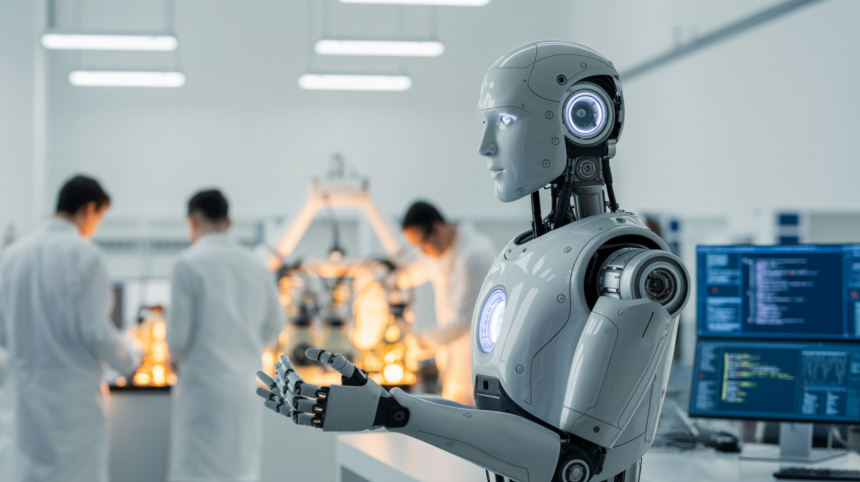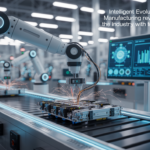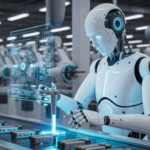Humanoid robots have been one of the most fascinating and disruptive advancements in technology in recent years. With their human-like appearance and actions, these robots are not just changing the way industries operate but are also influencing how we interact with technology.
From healthcare and manufacturing to education and entertainment, humanoid robots are beginning to make their presence felt. But what exactly are humanoid robots, and why are they such a significant development in the world of technology?
What Are Humanoid Robots?
Humanoid robots are robots designed to resemble the human form, both in appearance and movement. These robots can have two arms, two legs, and even facial features that mimic human expressions. The primary goal of humanoid robots is to perform tasks that would typically require human intervention, particularly in environments that involve routine, repetitive, or dangerous tasks.
While humanoid robots can be quite advanced, they still lack many of the characteristics that define human beings, such as emotions, complex decision-making abilities, and consciousness. Nonetheless, they can perform tasks efficiently, sometimes with higher precision than humans.
Why Are Humanoid Robots Important?
The importance of humanoid robots extends beyond their intriguing appearance. They represent a major shift in how we think about technology and its role in our daily lives. Here are a few reasons why humanoid robots are becoming crucial:
- Task Automation and Efficiency: Humanoid robots can carry out repetitive tasks, which can significantly boost productivity in sectors like manufacturing and logistics. Their efficiency in performing tasks that require precision and endurance makes them valuable assets in these fields.
- Enhancing Human-Machine Interaction: The design of humanoid robots is centered around improving human interaction with machines. By resembling humans in structure, humanoid robots can engage with people in ways that are more intuitive and natural than traditional machines. This can help bridge the gap between human capabilities and machine performance.
- Potential for Assistance in Healthcare: Humanoid robots are beginning to be used as assistants in healthcare settings, where they help with everything from elderly care to surgery. These robots can assist in lifting patients, managing medication, or even providing companionship for those who need it most.
- Exploration and Search-and-Rescue: Humanoid robots are also being developed to work in extreme environments, such as space exploration, underwater research, and search-and-rescue missions. Their human-like appearance allows them to navigate spaces and perform tasks in ways that other robots cannot.
The Evolution of Humanoid Robots
Over the past few decades, humanoid robots have evolved from rudimentary prototypes to highly sophisticated machines. The first humanoid robots, like Honda’s ASIMO, were designed primarily to showcase the potential of robotics. These robots could walk, perform basic gestures, and interact with people in limited ways. However, advancements in AI and robotics have led to robots that can perform increasingly complex tasks.
One notable milestone is the development of Sophia, a robot created by Hanson Robotics. Sophia gained worldwide attention for her ability to hold conversations, express emotions, and even make decisions. Sophia is considered one of the most advanced humanoid robots, and her abilities demonstrate the potential for humanoid robots to engage in more meaningful interactions with humans.
Where Are Humanoid Robots Being Used?
Healthcare
One of the key areas where humanoid robots are making an impact is in healthcare. Robots are being used to assist with patient care, surgery, and even mental health support. For instance, Robear, a Japanese humanoid robot, is designed to help lift patients who have difficulty moving. In addition, humanoid robots like Pepper are being used as companions for elderly people, providing emotional support and reducing loneliness.
Education
Humanoid robots are also finding their way into classrooms, where they serve as teaching assistants, educational tools, and motivators. Robots such as Nao are being used to teach children subjects like math, language, and science. These robots are designed to be engaging, using playful movements and interactive lessons to keep students interested.
Customer Service
Several companies are exploring the use of humanoid robots in customer service settings. Robots like Pepper and Softbank’s NAO are capable of greeting customers, answering their questions, and even making suggestions. These robots can help businesses enhance their customer service, especially in environments where human employees are overwhelmed or where there’s a need for round-the-clock support.
Manufacturing and Logistics
In the manufacturing sector, humanoid robots are increasingly being used to perform tasks like assembly, sorting, and quality control. Their human-like appearance and mobility make them well-suited for environments where human workers are needed to interact with delicate machinery or products. They can also be used in warehouses to move goods, organize inventory, and assist in other logistics-related tasks.
How Do Humanoid Robots Work?
Humanoid robots rely on a combination of hardware and software to function. The hardware typically includes motors, sensors, actuators, cameras, and other components that allow the robot to mimic human movements. The software, often powered by advanced artificial intelligence (AI), is responsible for processing information from the robot’s environment and making decisions about how the robot should act.
AI is particularly important in humanoid robots because it allows them to “learn” from their environment and improve their performance over time. Machine learning algorithms enable humanoid robots to recognize patterns, adapt to new situations, and make decisions without human intervention.
Common Features of Humanoid Robots
- Mobility: Humanoid robots often have legs and arms that allow them to walk, run, and perform tasks that require fine motor skills. Some robots, like ASIMO, can even run, climb stairs, and balance on uneven surfaces.
- Artificial Intelligence (AI): AI enables humanoid robots to perceive their environment, make decisions, and interact with people. Advanced AI allows humanoid robots to recognize voices, facial expressions, and objects.
- Sensory Systems: Humanoid robots are equipped with various sensors, such as cameras, microphones, and touch sensors, to gather data about their surroundings. These sensors help the robot understand and react to the world around them.
- Speech Recognition and Synthesis: Many humanoid robots are equipped with speech recognition systems that allow them to understand spoken commands and respond using synthetic speech. This enhances their ability to engage in conversations with humans.
The Challenges Faced by Humanoid Robots
Despite their advancements, humanoid robots still face several challenges that hinder their widespread adoption.
- Cost: Developing and manufacturing humanoid robots is expensive. The technology and components involved in creating robots that resemble humans in appearance and functionality often make them prohibitively expensive for many businesses.
- Complexity: While humanoid robots can perform many tasks, their ability to handle complex, unstructured environments is still limited. Robots often struggle with tasks that require problem-solving, such as navigating unknown spaces or dealing with unexpected situations.
- Ethical Concerns: As humanoid robots become more capable, concerns about their impact on human labor and society arise. Some fear that robots could replace human workers in certain industries, leading to job losses and economic disruption. Additionally, there are concerns about privacy and the ethical implications of AI in humanoid robots, particularly regarding how they gather and use data.
Myths About Humanoid Robots
- Humanoid Robots Will Replace Humans: While humanoid robots can automate many tasks, they are not yet capable of fully replacing human workers in many industries. The human touch is still essential in areas like healthcare and customer service.
- Humanoid Robots Are Fully Autonomous: Although humanoid robots can perform a range of tasks, they still rely on human oversight and interaction. They are not fully autonomous and require continuous programming and training.
- Humanoid Robots Are Emotionally Intelligent: While robots like Sophia are designed to simulate emotions, they do not experience feelings like humans do. They are simply programmed to recognize and mimic emotional expressions.
The Future of Humanoid Robots
As technology continues to advance, the future of humanoid robots looks incredibly promising. With improvements in AI, machine learning, and robotics, humanoid robots will become more capable, autonomous, and affordable. In the near future, we can expect to see humanoid robots performing a wider range of tasks in various industries, from healthcare to entertainment.
Humanoid robots have the potential to change the way we live and work. As their abilities continue to grow, they will increasingly become a valuable part of our society, helping us solve complex problems and improve our quality of life.
Conclusion: Embracing the Future of Humanoid Robots
Humanoid robots are not just a glimpse into the future—they are already here, and they are making a significant impact across a range of industries. While there are challenges ahead, the potential for humanoid robots to improve productivity, enhance human interaction with technology, and assist in fields like healthcare and education is undeniable. As the technology continues to evolve, humanoid robots will undoubtedly play a crucial role in shaping the future of our world.






